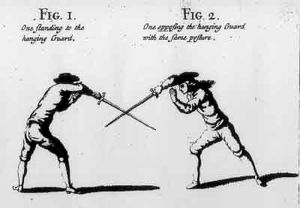Annotation:Sir William Hope's Scotch-measure: Difference between revisions
Created page with "__NOABC__ <div class="noprint"> <p><font face="sans-serif" size="4"> Back to [[{{BASEPAGENAME}}]] </font></p> </div> ---- {{#lst:{{PAGENAME}}|abc}} ---- <div style="page-break..." |
No edit summary |
||
| (2 intermediate revisions by the same user not shown) | |||
| Line 10: | Line 10: | ||
<div style="text-align:justify;"> | <div style="text-align:justify;"> | ||
{{break}} | {{break}} | ||
'''SIR WILLIAM HOPE'S SCOTCH-MEASURE.''' Scottish, Scotch-Measure (Reel). D Major. Standard tuning (fiddle). AB. The tune appears in Henry Playford's 1700 collection of Scottish dance music. The collection contains the first mention of the term 'Scotch Measure' in print. | [[File:Hopeguard.jpg|thumb|Guard position, Hope's treatise.]] | ||
'''SIR WILLIAM HOPE'S SCOTCH-MEASURE.''' Scottish, Scotch-Measure (Reel). D Major. Standard tuning (fiddle). AB. The tune appears in Henry Playford's 1700 collection of Scottish dance music. The collection contains the first mention of the term 'Scotch Measure' in print. Sir William Hope (1660–1724). 9th Bart. of Kirkliston, served in the army and was widely travelled. He was an accomplished Cavalier, renowned for skill in fencing and horsemanship, and gracefulness and agility in dancing. He was a longtime Deputy Governor of Edinburgh Castle, a position he held until his death of a "fever caused by over-dancing." He was the author of several seminal books on swordsmanship; his first was '''The Sword-Man’s Vade Mecum: A Preservative against the Surprize, of a Sudden Attaque with Sharps, &c. Being a Reduction of the most Essential, Necessary, and Practical part of Fencing; into a few Special Rules, With their Reasons: Which all Sword-Men should have in their Memories when they are to Engadge; but more especially if it be with Sharps''' (1691). It was followed by other illustrated treatises, including '''Highland Swordsmanship: Techniques of the Scottish Swordmasters'''. | |||
{{break|2}} | {{break|2}} | ||
</div> | </div> | ||
| Line 21: | Line 22: | ||
</font></p> | </font></p> | ||
<p><font face="sans-serif" size="3"> | <p><font face="sans-serif" size="3"> | ||
<font color=red>''Printed sources''</font> : - Playford ('''A Collection of Original Scotch-Tunes, Full of the | <font color=red>''Printed sources''</font> : - Playford ('''A Collection of Original Scotch-Tunes, Full of the Highland Humours for the violin'''), London, 1700; No. 13, p. 6. | ||
{{break|2}} | {{break|2}} | ||
</font></p> | </font></p> | ||
Latest revision as of 04:26, 21 October 2019
X:1 T:Sir William Hope's Scotch-measure M:C| L:1/8 B:Henry Playford - A Collection of Original Scotch-Tunes, (Full of the B:Highland Humours) for the violin (London, 1700, No. 13, p. 6) N:"Most of them being in the Compass of the Flute." Z:AK/FIddler's Companion K:D dA|F2d2d2a2|f3e decA|FADE Ffed|c2e2e2 fg| agfe cAFA|dBGB ecAf/g/|afge fdeA|F2d2d2|| fg|abag fgfe|f2a2a2 DE|FAFA BGBd|c2e2e2 fg| afdB ecAF|dBGE cAFD|FBAd ceEA|F2D2D2||

SIR WILLIAM HOPE'S SCOTCH-MEASURE. Scottish, Scotch-Measure (Reel). D Major. Standard tuning (fiddle). AB. The tune appears in Henry Playford's 1700 collection of Scottish dance music. The collection contains the first mention of the term 'Scotch Measure' in print. Sir William Hope (1660–1724). 9th Bart. of Kirkliston, served in the army and was widely travelled. He was an accomplished Cavalier, renowned for skill in fencing and horsemanship, and gracefulness and agility in dancing. He was a longtime Deputy Governor of Edinburgh Castle, a position he held until his death of a "fever caused by over-dancing." He was the author of several seminal books on swordsmanship; his first was The Sword-Man’s Vade Mecum: A Preservative against the Surprize, of a Sudden Attaque with Sharps, &c. Being a Reduction of the most Essential, Necessary, and Practical part of Fencing; into a few Special Rules, With their Reasons: Which all Sword-Men should have in their Memories when they are to Engadge; but more especially if it be with Sharps (1691). It was followed by other illustrated treatises, including Highland Swordsmanship: Techniques of the Scottish Swordmasters.
